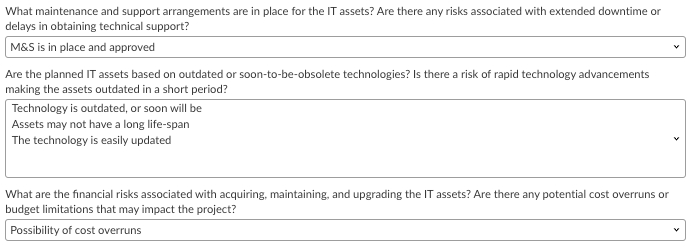Use Cases - Capacity Planning
When planning your IT asset capacity requirements, it's important to consider various risk factors that may impact your operations.
How to Assess Risk in Capacity Planning
Assessing risks in capacity planning for IT Service Management involves identifying potential threats or uncertainties that may impact the ability to meet service demands and deliver optimal performance.
By systematically assessing and addressing risks in capacity planning, IT Service Management can proactively mitigate potential issues, optimize resource allocation, and ensure the ability to meet service demands effectively.
Here are some risk-related questions you should ask:
Scalability Risk:
How scalable is the proposed IT infrastructure to accommodate future growth and increased demand?
Are there any limitations or bottlenecks that may hinder scalability?
Performance Risk:
What is the expected performance of the IT assets under various load conditions?
Have performance benchmarks and testing been conducted to ensure optimal performance?
Redundancy and Fault Tolerance Risk:
Are there redundant components or systems in place to minimize the risk of single points of failure?
Have measures been taken to ensure fault tolerance and high availability of critical systems?
Security Risk:
What security measures are in place to protect sensitive data and prevent unauthorized access?
Are there any vulnerabilities or potential risks associated with the proposed IT assets?
Compliance and Regulatory Risk:
Does the IT infrastructure comply with relevant industry regulations and standards?
Are there any legal or compliance risks associated with the planned IT assets?
Vendor and Supplier Risk:
How reliable and trustworthy are the vendors or suppliers providing the IT assets?
Are there any potential risks or dependencies on specific vendors that may impact operations?
Disaster Recovery and Business Continuity Risk:
Is there a comprehensive disaster recovery plan in place to mitigate the risk of data loss or system downtime?
Have backups and offsite storage solutions been implemented to ensure business continuity?
Maintenance and Support Risk:
What maintenance and support arrangements are in place for the IT assets?
Are there any risks associated with extended downtime or delays in obtaining technical support?
Technology Obsolescence Risk:
Are the planned IT assets based on outdated or soon-to-be-obsolete technologies?
Is there a risk of rapid technology advancements making the assets outdated in a short period?
Budget and Cost Risk:
What are the financial risks associated with acquiring, maintaining, and upgrading the IT assets?
Are there any potential cost overruns or budget limitations that may impact the project?
By considering these risk questions, you can identify potential vulnerabilities and make informed decisions to ensure a robust and reliable IT asset capacity plan.
Implement A Capacity Planning Process in ASM
To set up a Capacity Planning Workflow in Alemba Service Manager, you can follow these steps:
Identify Workflow Stages:
Determine the stages involved in your capacity planning process. This may include stages like "Demand Forecasting," "Resource Analysis," "Capacity Assessment," "Planning and Allocation," and "Monitoring."
Define Custom Forms and Templates:
Create custom forms or templates to capture relevant information at each stage of the capacity planning workflow.
Define the required fields, data types, and validation rules to ensure accurate data collection.
Include fields for capturing demand projections, resource utilization data, capacity assessment criteria, and allocation decisions.
Design Process Flows:
Map out the sequential flow of the capacity planning workflow using process flows in Alemba Service Manager.
Define the conditions and triggers for transitioning from one stage to another.
Configure automated notifications and reminders to keep stakeholders informed about their tasks and deadlines.
Assign User Roles and Permissions:
Assign appropriate user roles and permissions to ensure that only authorized individuals can access and modify the capacity planning workflow.
Define roles for demand analysts, capacity planners, approvers, and other stakeholders involved in the process.
Set up access controls to restrict sensitive data to authorized personnel.
Integration with Data Sources:
Integrate Alemba Service Manager with relevant data sources, such as monitoring tools or resource management systems, to gather real-time data on resource utilization and demand trends.
Ensure seamless data synchronization and updates within the capacity planning workflow.
Reporting and Analytics:
Configure custom reports and dashboards to provide insights into capacity utilization, demand patterns, and planning outcomes.
Define key performance indicators (KPIs) and metrics to monitor the effectiveness of capacity planning efforts.
Analyze data and generate reports to support decision-making and resource optimization.
Test and Deploy the Workflow:
Validate the capacity planning workflow by conducting thorough testing, ensuring that it aligns with your organization's requirements.
Gather feedback from stakeholders and make necessary adjustments before deploying the workflow to production.
Training and Communication:
Conduct training sessions to familiarize users with the capacity planning workflow, its stages, and their responsibilities.
Communicate the purpose and benefits of the workflow to stakeholders and encourage their active participation.
By following these steps, you can establish a Capacity Planning Workflow within Alemba Service Manager, enabling effective management of resource allocation, demand forecasting, and optimizing capacity utilization in your organization.
Example Capacity Planning Workflow Template
Your capacity Planning Workflow template will typically take the form of several questions tied to the risk calculator that will then formulate the overall risk. You can approach this a few ways:
You can create individual task screens for each group that will be completing the plan (if you have questions that only certain groups can answer, for example). As they answer the risk questions, they will update the main request.
You can simply put all the questions on the request and let them be completed at the Request level instead.
The workflow that sits behind the request and what you will do with the results, will be configured to follow your current process.


Was this helpful?
